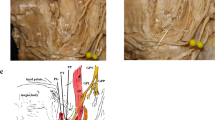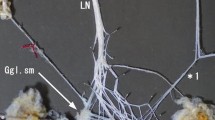Abstract
The neuro-motor control of the human tongue musculature had not been investigated in detail. This study identified first that the lingual nerve should play the neuro-motor control of some lingual muscles. Six en bloc samples (12 sides), including the tissues from the skull base to the hyoid bone, and three whole tongues were obtained from adult human cadavers. The former samples were used for the study of nerve fiber analysis of the lingual nerve with the aid of binocular stereomicroscope, and the latter samples were used for histological study by serial section method. On nerve fiber analysis of the lingual nerve from the trigeminal ganglion to the tongue musculature, we found that the motor- root of the trigeminal nerve gave off its supply to the lingual nerve and traveled into the lingual nerve, and branched to the superior and the inferior longitudinal muscles. On histological study, it was revealed that in the anterior part of the tongue the superior and the inferior longitudinal muscles surrounded the other lingual musculature and combined with the sub-mucosal connective tissues closely like the cutaneous muscle, for example, the facial muscles. The lingual nerve entered the inner side of the space between the genioglossus and the inferior longitudinal muscles with the lingual artery. These findings suggested that the superior and the inferior longitudinal muscles should be innervated by the motor fibers traveled into the lingual nerve from the motor root of the trigeminal nerve, and do not originate from the myotome originating in occipital somites but branchial muscles.








Similar content being viewed by others
References
Borden JG, Harris KS (1934) Speech science primer 2nd Ed. Williams & Wilkins, Baltimore, pp 145–147
Fitzgerald MJT, Law ME (1958) The peripheral connexions between the lingual and hypoglossal nerves. J Anat 92:178–188
Hirose H (1986) Pathophysiology of motor speech disorders (dysarthria). Folia Phoniat 38:61–88
Hogden J, Lofqvist A, Gracco V, Zlokarnik I, Rubin P, Saltzman E (1996) Accurate recovery of articulator positions from acoustics: new conclusions based on human data. J Acoust Soc Am 100:1819–1834
Kameda K (1952) Über den n. mandibularis bei Japanern. Acta Instituti Anatomici Niigataensis 118:1–19
Marcus H (1934) Zur stammesgeschichte der Zunge ? Ueber Muskulatur in der polypteruszunge. Anat Anz 77
Portmann A (1969) Einführung in die vergleichende morphologie der wirbeltiere. Schwabe & Co, Basel pp 64–66
Portmann A (1969) Einführung in die vergleichende morphologie der wirbeltiere. Schwabe & Co, Basel, pp 180–182
Romer AS (1970) The vertebrate body 4th edn. WB Saunders, Philadelphia, pp 242–279
Sadler TW (2000) Langman’s medical embryology 8th edn. Lippincott Williams & Wilkins, Baltimore, pp 345–381
Sahara Y, Hashimoto N, Kato M, Nakamura Y (1988) Synaptic bases of cortically-induced rhythmical hypoglossal motoneuronal activity in the cat. Neurosci Res 5:439–452
Sahara Y, Hashimoto N, Nakamura Y (1996) Hypoglossal premotor neurons in the rostral medullary parvocellular reticular formation participate in cortically-induced rythmical tongue movements. Neurosci Res 26:119–131
Saigua H, Yamashita K, Tanuma K, Niimi S (2004) Morphological studies for retrusive movement of the human adult tongue. Clin Anat 17:92–98
Takemoto H (2001) Morphological analysis of the human tongue musculature for three-dimensional modeling. J Speech Language Hearing Res 44:95–107
Acknowledgements
This study was supported by a scientific research grant from the Ministry of Education, Science, Sports, Culture and Technology of Japan (B (2) 14770930). The authors thank Miss Y. Hachiya, Department of Anatomy, Nippon Medical School, for her special technical support.
Author information
Authors and Affiliations
Corresponding author
Rights and permissions
About this article
Cite this article
Saigusa, H., Tanuma, K., Yamashita, K. et al. Nerve fiber analysis for the lingual nerve of the human adult subjects. Surg Radiol Anat 28, 59–65 (2006). https://doi.org/10.1007/s00276-005-0037-0
Received:
Accepted:
Published:
Issue Date:
DOI: https://doi.org/10.1007/s00276-005-0037-0




